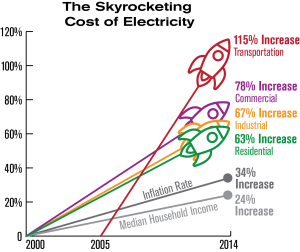Electromagnetic energy (EM) is otherwise called electromagnetic radiation or EM radiation. The two terms portray the energy that moves in floods of various frequencies. There are many kinds of electromagnetic energy recognizable through their shifting frequencies. These waves are comparable but at the same time are prepared to do “doing” various things. We measure rates of Houston Electricity Plans on the electromagnetic range.

7 Kinds of Electromagnetic Radiation
There are seven unique gatherings of radiation frequencies in the electromagnetic range. We’ll begin with the longest frequency, with the least energy, and move along the range, expanding how much energy and shortening the frequency.
- Radio waves — the longest frequency, with the least energy
- Microwave
- Infrared light (IR), or infrared radiation
- Apparent light
- Bright radiation (UV)
- X-beams
- Gamma beams — briefest frequency, with the most energy
For instance, we can’t see the sun’s bright light that can cause sun-related burns, however, we know UV radiation exists. We can’t see X-beams, yet we use them to give a depiction of our inward organs.
How Does Electromagnetic Energy Function?
To figure out electromagnetic energy, envision waves on an ocean side moving and colliding with the shore. Energy travels through the water — that energy is given by wind or the World’s gravitational force.
Influxes of EM radiation work in basically the same manner, spreading energy as they move. To comprehend EM radiation better, we want to focus on the nuclear level.
Iotas are made of a core with a positive charge that contains minuscule particles called neutrons and protons. Electrons convey a negative charge and are found in an iota’s shell encasing the core.
A core can become unsound when it ingests energy; it might make an electron leap to a higher energy level. At the point when the electron shifts back to its unique position, energy is delivered as electromagnetic radiation.
Two developments currently happen in a customary, rhythmical style called swaying. The main development is a wavering electric field. The second is a wavering attractive field.
At the speed of light, photons travel as waves. Every photon has various qualities:
- Frequencies: the distance between a wave’s successive pinnacles
- Recurrence: the number of waves inside a given time
Measure of energy
The electromagnetic wave, or energy, created by swaying electric and attractive fields, could be any of the seven sorts of various kinds of radiation recorded previously.
Electromagnetic Energy Estimated?
As we’ve seen, electromagnetic radiation is estimated by its energy, frequency, or recurrence. Researchers utilize various estimations given the immense distinction in frequencies.
A wave’s energy is a component of the idea of its swaying electric and attractive fields. An electromagnetic wave’s energy is corresponding to its adequacy squared. A wave’s sufficiency is the most extreme expansion of the swaying of the electric and attractive fields.
The more extended, low-energy waves like radio waves are estimated in recurrence and communicated as hertz. A few radio frequencies sway gradually and are more than 100km long! A medium recurrence (MHz) carries music to our radios. It is somewhere in the range of 100m and 1 kilometer long and measures around 3MHz (3 million hertz).
Radio waves have many frequencies and can go to billions of gigahertz (GHz). One gigahertz is comparable to 1,000 MHz, or 1,000 million hertz. This reach is called radio recurrence (RF).
Stargazers who study radio waves at space observatories, for example, NASA use frequencies or frequencies for their estimations. In any case, it’s difficult to work with such enormous numbers as we climb the range. The high-energy, more limited frequencies in X-beams and gamma beams are communicated as electron volts (eV).







